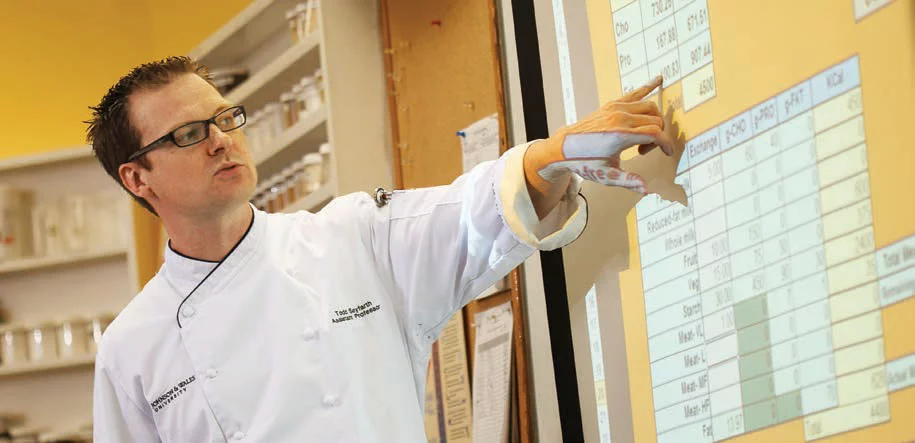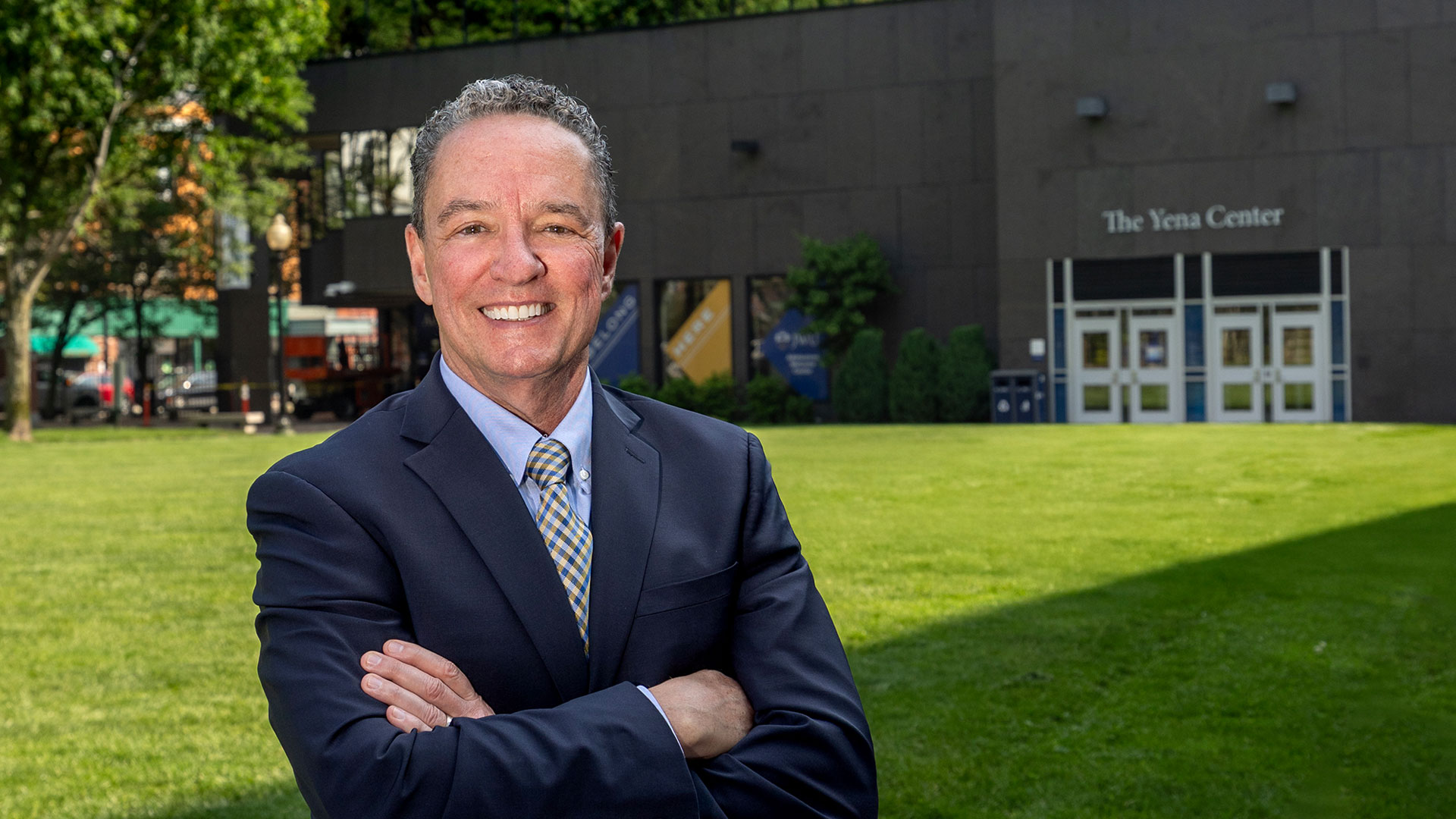Doctoring the Menu: Food as Medicine
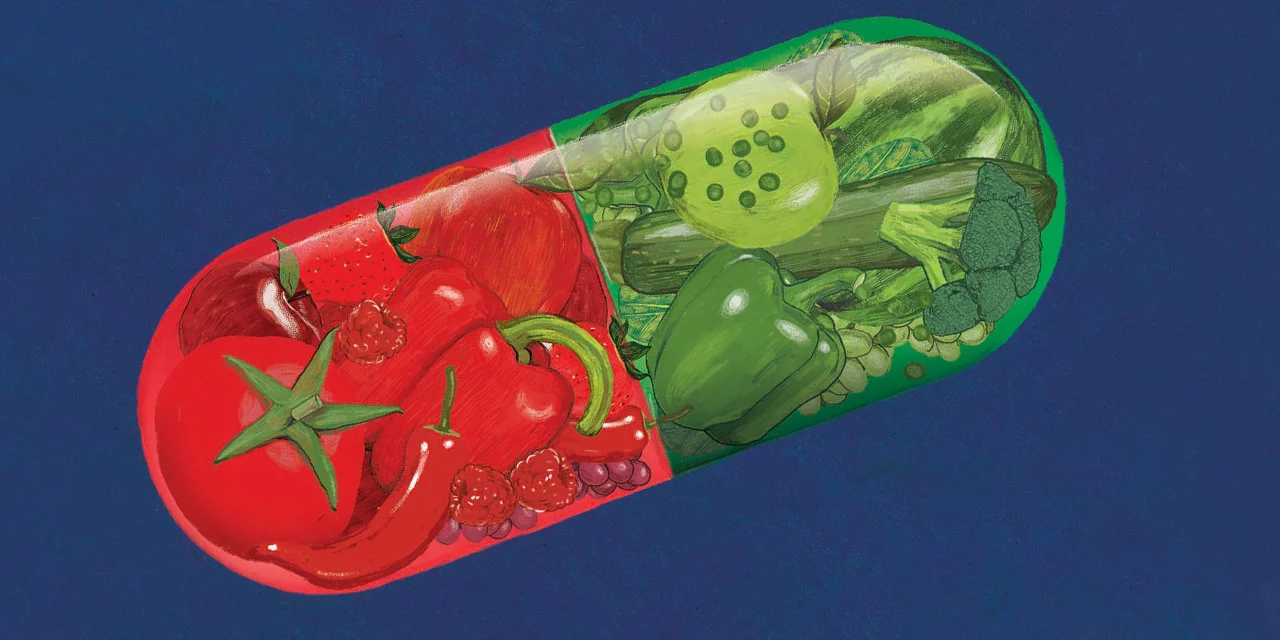
ILLUSTRATION BY BARRY FALLS
Clad in a crisp white apron and chef’s hat, Eric Sharer ’08 zips around a gleaming kitchen setting mixing bowls, utensils and ingredients on the island countertop. Butternut squash, cumin, paprika, chickpeas, kale — the foods and spices pile up beside the cutting board as Sharer consults his recipe. “We’re going to make something really fun today,” he tells his aproned co-chef, “using things you typically have on hand at home.”
The scene is straight out of a cooking demo TV spot, but there’s no studio audience, and Sharer’s 40-something co-chef isn’t a morning show host; she’s a patient enrolled in a 12-week weight-loss program at the Stram Center for Integrative Medicine in Delmar, New York, outside of Albany. Down the hall from the gourmet kitchen are acupuncture rooms, cardio machines, an oxygen therapy chamber, doctors’ offices and other holistic medicine facilities.
Sharer and his patient embody the growing movement of culinary medicine — a marriage of culinary art and the science of nutrition — in a clinical setting.
Sharer, who earned a culinary nutrition degree from the Providence Campus, is a registered dietitian and culinary nutritionist with a specialty in oncology nutrition. He provides nutritional counseling and cooking lessons for patients who have general wellness goals as well as more specific dietary needs related to problems such as cancer, diabetes, Lyme disease and digestive issues.
"We always partner a medical concept with the cooking." -Leah Sarris '05
“Patients can be very intimidated by eating,” Sharer says. “They don’t know how to eat because there’s so much information out there. Between frozen food and takeout, they don’t realize they’re not being taught to cook.”
That’s exactly the goal of the kitchen session: Sharer walks his patient through a slew of culinary techniques that yield a healthy lunch, plenty of flavor and — hopefully — a meal that the rest of her family will enjoy as well.
With hands-on instruction, Sharer demonstrates how to use a food processor to incorporate vegetables like broccoli in a salad; how to massage kale to make it more palatable; when to use olive oil versus canola oil; which spices hit the right flavor notes instead of salt; what body mechanics to employ for chopping vegetables effectively; and how to make a zingy dressing without the fat. It’s just one part of the patient’s weight-loss plan, but it’s important to maintain her momentum and make her health goals sustainable.
The end result — a winter salad of butternut squash, chickpeas, roasted nuts and southwest spices with maple Dijon vinaigrette — is clearly something she’d never have considered for a meal, and she’s a little skeptical as Sharer plates their creation. “What do you think of the flavors?” he asks. “Is this something you’d make at home?” She chews slowly, savoring the new tastes. “It’s really good,” she says. “I definitely would. I forgot the broccoli was even in there!”
Mission accomplished. Sharer’s culinary skills and nutrition knowledge complement the medical and naturopathic treatments the Stram Center offers, and it’s just one example of a movement that’s gaining momentum on a curricular level at Johnson & Wales. “Culinary medicine is applied nutrition,” says Chef Todd Seyfarth ’01, culinary nutrition chair at the Providence Campus. “It’s looking at evidence — a study that says ‘these foods are likely to have X result’ — and saying, ‘Here is how we create a menu that’s appropriate for your culture and social environment at a level that can hopefully prevent or manage disease.’”
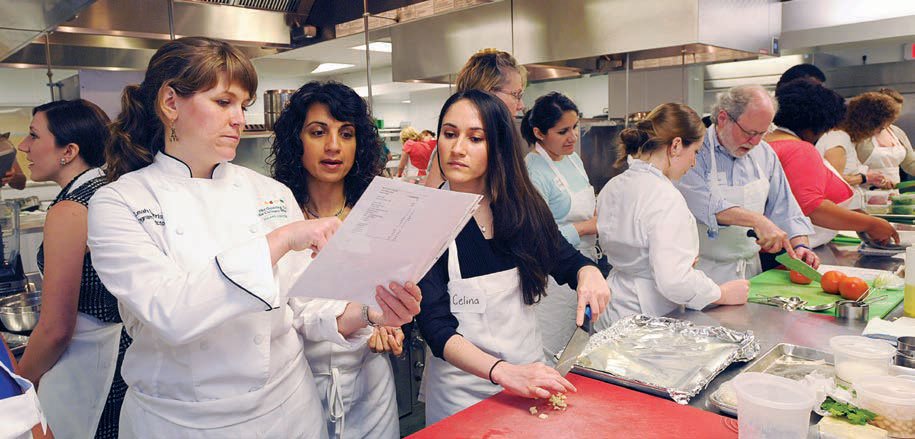
GOLDRING CENTER DIRECTOR LEAH SARRIS '05 TEACHING A NUTRITION CLASS.
HEALTHCARE, NOT SICK CARE
Study after study shows that poor diet is one of the biggest risk factors in disease and early death. It follows that the worse the diet, the greater the monetary healthcare costs.
So when the passage of the Affordable Care Act in 2010 ushered in an era with a greater focus on preventative healthcare as a sweeping change in the way we view medical problems and solutions, food choices began to play more of a starring role in the medical world.
“Culinary medicine is very much about preventative health,” Seyfarth says. “Everyone talks about how it’s not healthcare — it’s sick care. The surgeon general is talking about how healthcare costs are going to bankrupt the country. How can we fix this? You cannot get a more efficient use of money than teaching people to cook healthily. That’s the catalyst of this movement.”
And therein lies the problem, Sharer says. Who’s doing the teaching? Sure, anyone can consult a health practice about which vitamins and nutrients can help them lose weight or lower blood sugar. “But a lot of dietitians out there don’t know how to cook,” he says, and that’s important when they’re telling a patient to cut back on salt or fats. Unless they can provide an alternative way to make food taste good, healthful dietary guidelines can go unheeded.
“With training from Johnson & Wales, you can help make practical recommendations for flavor and texture,” he says. And that’s where JWU is taking the next step to educate not just future dietitians and nutritionists, but also physicians who need to discuss food choices with their patients.
"Culinary medicine is applied nutrition." -Chef Todd Seyfarth
DOCTORING A MEAL IN THE JWU LAB
Just ask Richard Buesa, a student at Brown University’s Warren Alpert Medical School who’s spending his Friday night in the kitchen — the classroom kitchen, that is, on the Providence Campus of Johnson & Wales. The problem, Buesa says, is that there’s very little instruction on nutrition and dietary concepts in medical school — which is why two dozen or so medical students are paired off at state-of-the-art cooking stations, whisking, chopping, blending and searing ingredients to create a feast that will serve as the culmination of an elective Food + Health course in partnership with JWU’s Culinary Nutrition Society.
In its second year, the pilot program invites medical students to spend five separate cooking sessions under the tutelage of culinary students and Chef Michael Makuch '03, MAT '05, a JWU associate professor and advisor for the nutrition society.
Each week, students from the two universities bring their disciplines together to tackle a nutrition problem by applying their respective skillsets.
Take hypertension: The medical students might provide a lecture discussing the physiological science behind the condition, while the culinary students lead the practical applications of creating a healthy, low-sodium meal that’s still flavorful and appealing with the addition of certain herbs and spices. Or perhaps the hypothetical challenge is a child who only eats white foods: “You have to figure out a way to get him more fiber,” Makuch says. “The students can think outside the box; it’s an interesting collaboration.”
The major goal is to build awareness. For the medical students, it’s about increasing their culinary literacy. Just getting them excited about it — that can pass down to their patients eventually. This is another tool to better relate to their patients and potentially improve health outcomes.”
This evening is the medical students’ first solo attempt at creating a range of dishes with ingredients purchased on a mock budget — an effort to tailor their newfound culinary knowledge to the real-world scenario of patients with limited grocery finances. The result, spread banquet-style over the butcher-block and stainless-steel surfaces of the JWU kitchen, is a mélange of fresh, colorful, creative dishes such as salmon-wrapped root vegetables with herb-infused olive oil and grilled skirt steak with chimichurri salsa and cauliflower mashed potatoes. The doctors-to-be proudly present their plates to their culinary counterparts for final evaluation of their skills and ingenuity.
“We’ve been developing a more hardcore curriculum to optimize it for the medical students and make it more applicable to their workplaces,” says Kyle Stuart ’17, president of the Culinary Nutrition Society. “The confidence in a doctor’s voice, knowing what he or she is talking about with food, is going to be really reassuring to a patient.”
THE ORIGINAL PILOT
The pilot program, which has also been launched at JWU’s Denver Campus with the University of
Colorado School of Medicine, is modeled after concepts developed in Tulane University’s Goldring Center for Culinary Medicine, in New Orleans, Louisiana.
“We always partner a medical concept with the cooking,” says Goldring Program Director Chef Leah Sarris '05, a former JWU adjunct instructor who built the Goldring curriculum from the ground up in 2012.
The center aims to provide Tulane’s medical students with the culinary and nutritional training — 9 cooking classes at three hours each — that a traditional medical education lacks. Plus, it offers free community classes to the public as well as continuing education classes to nurses, physician assistants and other health professionals.
“The Affordable Care Act has helped,” Sarris says. “Physicians can do lifestyle training and have it be billable hours. Preventative medicine falls in there quite nicely, too. Doctors are listening, and they’re excited about it. They’ve been talking about food with their patients, and that’s the outcome we’re hoping for.”
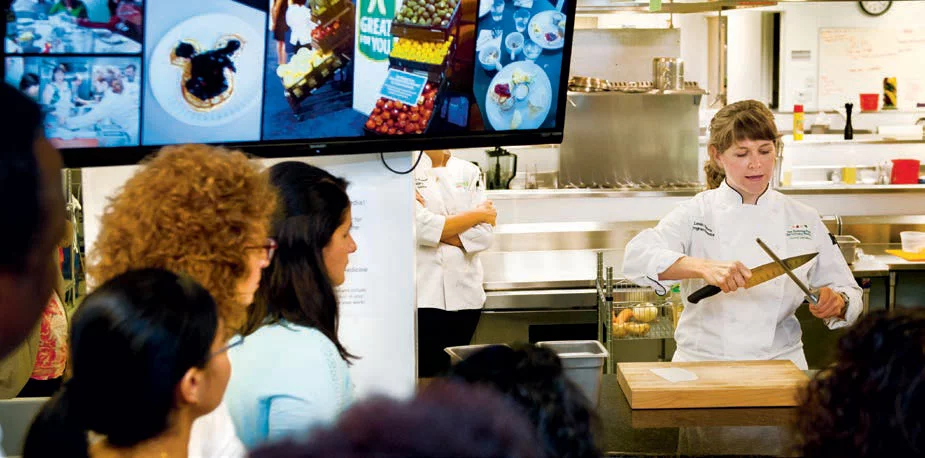
Goldring’s continuing education modules are taught partially by interns from JWU — part of a semester-long exchange partnership between the two institutions that sends JWU students to Tulane’s culinary medicine center, and Tulane’s medical students to a JWU “culinary boot camp” of sorts. It didn’t take long for JWU’s Providence Campus to realize there was another eager pool of medical students — just as badly in need of cooking skills — a heck of a lot closer than New Orleans, and the JWU-Brown Food + Health pilot program was born.
Twelve Brown medical students registered for the initial elective; one year later in fall of 2015, the course couldn’t accommodate the more than 60 medical students who were interested.
“There’s always been an interest in food,” Makuch says. “That continues to grow in our society as food becomes more glamorized. Consumers are starting to ask more questions about food and health in general. ‘Let food be thy medicine and medicine be thy food’ still holds true today. It’s a novel approach and it sounds almost too simple, but it can still be used in the tool kit. It’s very grassroots in many ways.”
As a pioneer of the concept, the Goldring Center offers a culinary medicine certification and has licensed its program to about 10% of the medical schools in the United States, with a dozen more in the works.
“The medical school curriculum is a very hard egg to crack,” Sarris says. “A lot of medical schools were not receptive in the beginning. In the long-term, we’d like to prove that people who go through our classes are healthier and more apt to provide nutritional counseling and therapy in their practices. We have to walk the talk so patients are more likely to listen.”
Back at JWU, Seyfarth says there’s been some tracking of the culinary boot camp outcomes. “The doctors that have been doing the rotation at Johnson & Wales are more comfortable teaching the nutrition concepts to their patients.”
"Culinary medicine is feeding people what they need to heal themselves."
FINE DINING, HOSPITAL STYLE
On the flip side of culinary medicine’s clinical applications are the administrative aspects of integrating food science into healthcare settings, and JWU alumni are leading the charge to overhaul hospital food service programs.
“I see the culinary side and the nutrition side, and how in healthcare they need to work together,” says Angelo Mojica '95, the senior enterprise director of nutrition and food services at the Cleveland Clinic in Ohio. “Hospital food was bad because we didn’t have a lot of money, not because we couldn’t make good food. I developed a model that both reduces expenses and increases patient satisfaction.”
Mojica is referring to a retail room-service concept he’s introducing at the Cleveland Clinic, much like the award-winning Restaurant Delivery Program he implemented while overseeing University of North Carolina healthcare food services.
He created a 20-page menu that offers items such as made-to-order chopped salads, sushi, seasoned chili-lime shrimp burritos and low-sodium chicken stir-fry.
“There is healing in food,” Mojica says, and that goes as much for providing choices and variety as it does for getting patients the type of nutrition that will help them recover — and marketing it wisely.
Cancer or cystic fibrosis patients, for instance, need fat and calories — but often have no appetites. Tasteless food doesn’t help. “A supplement shake provides everything you need except taste,” he says. “In fact, it tastes really terrible. You’d send it up to the patient and it would come back down. So I said, let’s change this and do a real milkshake.”
The kitchen got a milkshake machine that does strawberry, chocolate and vanilla, added high-quality protein powder and a nutritional supplement, created a product logo with a hero in a cape, and called it the Super Shake. “That is culinary medicine: Feeding people what they need to heal themselves,” Mojica says. “You have to make the food good — not good for hospital food, but good for any food.”
Healthcare facilities across the country are similarly shifting their thinking to enhance their culinary offerings. Take the world-renowned Boston Children’s Hospital, which unveiled an $11 million cafeteria overhaul this past summer.
With Patient Support Services Director Shawn Goldrick ’96 at the helm, Boston Children’s transformed an uninspired retail restaurant space into an innovative hub of culinary activity with a Chef’s Playground station that includes healthy cooking lessons, celebrity chef demonstrations and cooking sessions geared toward specific diseases.
At the Stram Center, Sharer knows the impact a cooking demonstration can have, whether it’s at an outpatient visit, a hospital cafeteria or a JWU kitchen classroom. He’s packaged up the leftovers from the butternut squash dish they’ve prepared to send home with his patient. It’s one of about 30 recipes she’ll receive.
Sharer wishes more healthcare providers could talk their patients through specific food choices and culinary techniques.
“Most doctors aren’t trained that way, but there’s a strong possibility with this pilot program of changing our healthcare system with the idea of prevention,” he says of JWU’s new Food + Health collaboration. “I’m a big believer that knowledge is power.”
This article originally appeared in the Winter 2016 issue of JWU Magazine.
TODD SEYFARTH '01 TEACHING NUTRITION CONCEPTS TO MEDICAL STUDENTS.
